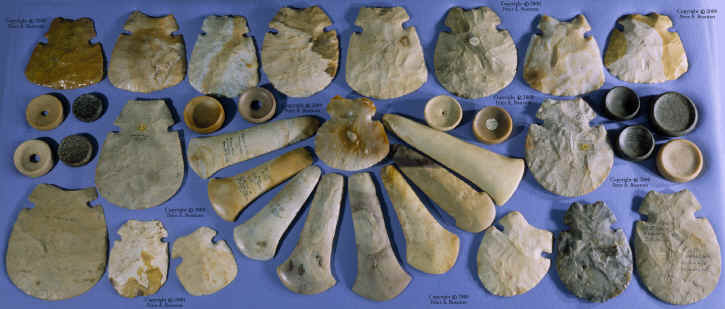|
JULY
2000 PICTURE
MISSISSIPPIAN ARTIFACTS
CAHOKIA CULTURE
FLOYD
RITTER COLLECTION
"Click
On Picture For Very Large Detailed Image" (approx. 65 sec.)

The artifacts in this picture represent one of the best collections of
Cahokia Culture artifacts from the area around the Cahokia Mounds State
Historic site. The site is located just east of St. Louis, Missouri in
Madison and St. Clair Counties in Illinois. These artifacts date to
somewhere between A.D. 800 to 1500.
The rarest artifacts in this picture are the eight ground and
polished Spuds located in the center. Spud is the common name given to
these artifacts. They are also known as Spatulate Celts or Ritual Axes.
The exact purpose for which they were used is unknown. They show no use
wear. They may have been hafted and used like a battle axe.
The sixteen Notched Hoes in this picture are excellent
examples of a popular form of digging tool used by the Cahokia people.
They are called St. Clair Side-Notched hoes, named after the county on
which part of the Cahokia site is located. Most of these Hoes were
made of the dull brown and gray Mill Creek chert from southern Illinois.
Only a very few of these Hoes were made of the more colorful kaolin chert
also quarried from sites in southern Illinois. At least six of these Hoes
are made of Kaolin chert.
The twelve ground and polished round stones in this pictures
are called Discoidals. Discoidals or "Chunky Stones", as they
are sometimes called, are usually concave on both faces with rare examples
having a central hole like the four in this picture illustrate. These
artifacts appear throughout the Mississippian period. Some early explorers
witnessed a game in which the Discoidal was rolled and two players threw
their six foot long sticks, or tchung-ke as they were called, each hoping
their spear would lay closest to the stone when it stopped rolling.
|